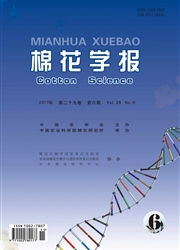

 中文摘要:
中文摘要:
通过分析1994-1995年在陕西杨陵和山东的鄄城、泰安、东营以及2001--2002年在长江流域棉花品种试验区域进行的试验资料,在不考虑土壤、栽培调控等因素的前提下,确定棉花铃期日均最低温、日均最高温和相对湿度、夜均温和日均降水量分别是影响棉纤维长度、比强度、麦克隆值的关键气象因子,并建立了基于铃期关键气象因子对棉纤维长度、比强度和麦克隆值的气象生态模型。上述模型既强调了遗传性对棉纤维品质性状的决定作用,也体现了气象生态因子的作用。棉纤维长度、比强度和麦克隆值气象生态模型RMSE分别为0.985mm、1.003cN.tex^-1和0.233,模拟值与观测值1:1直方图吻合度好,模型具有较好的预测性。
 英文摘要:
英文摘要:
Cotton fiber length, strength and micronaire are the main quality characters determined by eultivar characteristics, environment and cultivation, and could be used to making sure cotton fiber quality. The objective of this research was to determine the effects of meteorology on fiber properties of cotton and found key meteorologic factors-based model of fiber length, strength and mieronaire. Experiments were random block design with three replications with different eultivars and conducted in different places. Data was collected from 1994--1995 in Shanxi and Shandong province which use three eultivars,and from 2001--2002 in 37 places including cotton variety test region of the Yangtze river, Shanxi and Shandong province which involves 20 eultivars. All experiments are the same in treatments so that experimental errors of soil and environment can be reduced. Based on known research achievement in relationship of cotton fiber quality and eultivars and meteorologic factors, by analyzing experimental data above, the key meteorology factors which significantly affected fiber length, strength, mieronaire was determined. The results showed that fiber length was significantly affected by daily average minimum temperature during bolling stage, and so as fiber strength was daily average maximum temperature and relative humidity, and fiber mieronaire was daily night temperature and daily average precipitation, respectively. Then, key meteorologic factors-based models of fiber length, strength and mieronaire were set up, respectively. These non-liner models calculate both quality of cultivar variables (fiber length, strength, micronaire) and environmental variables (temperature, solar radiation, relative humidity). The RMSE (Root Mean Square Error) of key meteorologic factors-based models of fiber length, strength and micronaire were 0. 985 mm, 1. 003 cN·tex^-1 and 0. 233, respectively. Meanwhile, the 1:1 figs of simulated and observed fit well. All results showed that the models could make good prediction. Fu
 同期刊论文项目
同期刊论文项目
 同项目期刊论文
同项目期刊论文
 期刊信息
期刊信息
